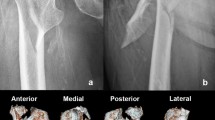Abstract
A patient is presented in whom massive fat emboli syndrome (FES) developed after the unsuccesful treatment of a solitary tibial fracture with an unreamed tibial nail. Ultimately, a reamed tibial nail was inserted. Several risk factors for the development of FES were identified retrospectively in this particular case: a very small medullary canal, a large-diameter unreamed tibial nail, reaming of a small medullary canal and insertion of a thick reamed tibial nail. Even in the presence of patients with solitary lesions and without obvious risks for FES, one should always take this dangerous complication into account.
Similar content being viewed by others
References
Duis HJ ten, Nysten MW, Klasen HJ, Binnendijk B (1988) Fat embolism in patients with an isolated fracture of the femoral shaft. J Trauma 28:383–386
Ganong RB (1993) Fat emboli syndrome in isolated fractures of the tibia and femur. Clin Orthop 291:208–214
Müller C, McIff T, Rahn BA, Pfister U, Perren SM, Weller S (1993) Influence of the compression force on the intramedullary pressure development in reaming of the femoral medullary cavity. Injury 24S:36–39
Müller C, Frigg R, Pfister U (1993) Effect of flexible drive diameter and reamer design on the increase of pressure in the medullary cavity during reaming. Injury 24S:40–47
Pape HC, Dwenger A, Regel G, Tscheme H (1991) Hat die Lungenkontusion und allgemeine Verletzungsschwere einen Einfluß auf die Lunge nach Oberschenkelmarknagelung. Ein tierexperimentelles Modell. Unfallchirurg 94:381–389
Vanderschot PM, Bosmans LR, Broos PLO (1993) Peroperative complications with a solid intramedullary nail, the Brooker Wills nail. Osteosynthese International 1:78–83
Wenda K, Runkel M, Degreif J, Ritter G (1993) Pathogenesis and clinical relevance of medullary fat embolism in intramedullary nailing demonstrated by intra-operative echocardiography. Injury 24S:73–81
Wozasek GK, Redl H, Schlag G (1995) Fettembolisation ein Epiphänomen der Marknagelung. In: Rommens PM, Vécsei V (eds) Osteosynthese International 1994. Leuven University Press, Leuven, pp 206–210
Author information
Authors and Affiliations
Rights and permissions
About this article
Cite this article
Rommens, P.M., Claes, P. Massive fat emboli syndrome after unsuccessful unreamed nailing of the tibia. Arch Orthop Trauma Surg 116, 184–186 (1997). https://doi.org/10.1007/BF00426070
Received:
Issue Date:
DOI: https://doi.org/10.1007/BF00426070




